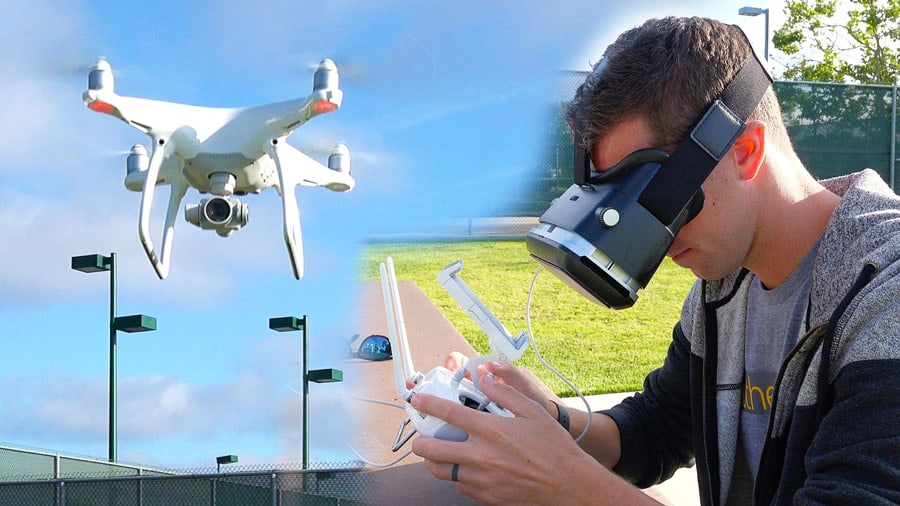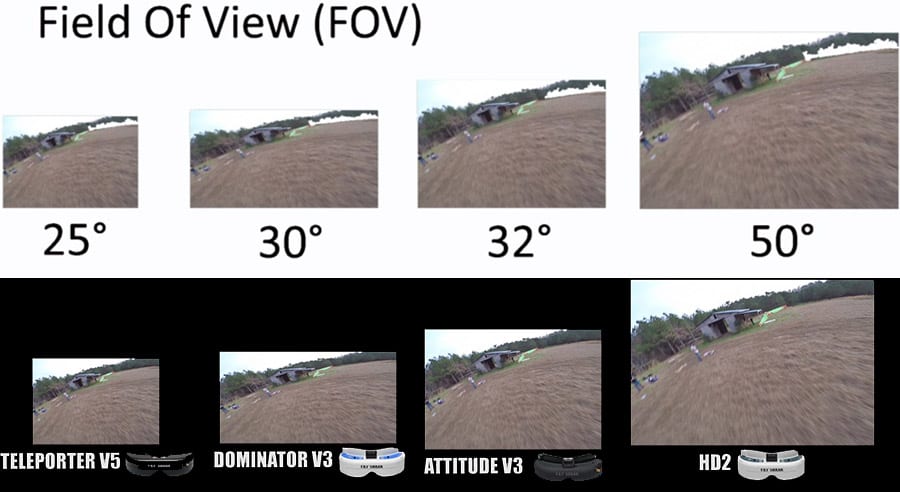Nowadays, a huge part of the market is going solely to the FPV-ready drones. Whether you are looking for standard aerial photography drones or racing ones, there’s no doubt you will be able to land a complete FPV package to come along with your pick. With the rapid growth of drone racing goggles’ popularity, it is not that surprising to see the best FPV goggles being in the focal point of the market during the last couple of months.

Photo source: Youtube.com
Driven by those changes on the market, I decided to make a standalone article that will have all the necessary (FPV in general and FPV goggles review related) information gathered up in one single place. With that being said, you can expect a plethora of information in the next couple of paragraphs. So, without much further adue, let’s kick it off and find out what are the Top FPV goggles for drones, and what is the best FPV drone.
FPV Goggles: Useful terminology
Before we kick things off with a list of FPV goggles for drones, there are certain terms you will need to get accustomed to before heading straight to action. That’s why we have prepared a list of the most frequently used abbreviations in this article as well as their respective definitions:
- FPV
Stands for First Person View. - LOS/BVLOS
Stands for Line of Sight / Beyond Visible Line of Sight. This abbreviation is frequently used with FAA’s regulations revolving around BVLOS flying. - FPV System
This term represents a complete set of accessories that combined together form a specialized system for enjoying FPV. - Racing Drones
Racing drones are made of highly durable but lightweight materials and have extremely powerful motors that allow them to reach amazing speeds. - Aerial Photography drones
Drones that were built for the sole purpose of maintaining a steady flight which results in superior image/video quality. - VR Boxes
Big, bulky headsets (similar design to that of Oculus Rift or HTC Vive) which possess 1 display inside, usually have 4 to 6 inches diagonally. - Standalone FPV Goggles
These FPV goggles have built-in displays that allow them to work without smartphones or tablets. If you want a high-quality FPV experience, you should definitely get one of these. - Smartphone-powered FPV Goggles
Common FPV Goggles that don’t have built-in displays. Instead, they rely on smartphones to act as displays and provide you with the live stream from your drone’s FPV camera. AKA VR headsets. - Latency/lag
Gamers are very familiar with this term. Latency/lag represents the time it takes for your FPV system to transport the action to your display or FPV goggles. If there’s too much lag, you will not be enjoying your FPV experience at all. - Jelly Effect
Commonly used for describing aerial footage captured by drones. The term jelly effect represents a certain degree of shakiness present in the footage due to running propellers. The best FPV drone on our list does not have any jello effect. In most of the cases, none of the drones with gimbal won’t have a jello effect. - Interpupillary distance
This term is often associated with FPV goggles. It represents the distance between the center point and the lens of the FPV goggles. AKA IPD.
Are FPV goggles for drones worth the money?
For people who want to experience FPV in its fullest glory, FPV goggles are a must. Likewise, professional drone racers also greatly benefit from them (in fact, there are more than a few drone racing competitions which require FPV goggles to be used during races). Not only do FPV goggles provide a lag-free experience but they also put professional races in “behind the wheel” state, allowing them to fully immerse themselves in the race. Needless to say, this improves their reaction times, increases their concentration and allows them to perform at the very best.
For regular Joes, I would not really recommend enthusiast-grade FPV goggles. Even though they’re outstanding at what they do, they’re just not worth the money (unless you’re a rich CEO of some sort… if that’s the case, go grab yourself a pair… perhaps get one for me too). Besides, most regular Joes won’t even be able to set them up properly (we’ll talk more about this later on) as they require quite a bit of expertise.
Instead, I’d warmly recommend one of those relatively cheap VR headsets which rely on smartphones as displays. They can be picked up for dirt cheap and are still able to give you a feel for the FPV goggles review bandwagon. For all of you who are just getting started with drones, I’d recommend trying out FPV via these bad boys. If you really like it and if you perhaps consider taking up drone racing as a hobby, then (and only then) it would be wise to make the “standalone FPV goggles” upgrade. They are much more expensive but provide a massive boost to the immersion.
Key benefits of FPV goggles – FPV goggles review
As I have already explained above, FPV goggles bear the most benefits to professional drone racers. These high-end FPV systems allow them to be in the very center of the action and basically put them in an optimal drone piloting environment. Once they put their FPV goggles on, these professional racers are completely cut away from their bodies and are transferred to their drones. High-end FPV systems have virtually no lag and are equipped with state of the art FPV cameras that are able to track all movement with the flick of the wrist. This sort of cutting edge technology is what’s making drone racing as a brand-new sport so much fun… but unfortunately, it also makes drone racing as a hobby much more expensive.
Getting started with FPV goggles
In this section, I will tell you a bit more about FPV goggles and what exactly you should look out for when buying them. It’s not nuclear science, don’t worry! There are just a couple of key aspects that you should know about before making your decision!
3 main types – FPV goggles comparison
Starting off, the first thing you should know about FPV goggles is that they come in 3 types – VR Boxes, VR goggles and smartphone-powered ones (this was already mentioned a couple of times).

-
VR Boxes
VR Boxes are much bulkier than their VR Google counterparts. While this is good when it comes to comfort (our users claim that VR boxes are really comfortable), prolonged use could put a strain on your neck since they are rather heavy. Resolution-wise, most VR boxes can’t brag with full HD. Luckily, their prices match that – they’re cheaper than VR Googles. In addition to that, they also have only 1 screen while VR Googles have 2 separate ones which make up for better viewing experience.
-
Standalone VR Googles
While these are definitely the priciest investment, it is safe to say standalone VR goggles provide the best FPV experience. They are used by all professional drone racers. With 2 separate high-quality displays, IPD adjustment and even head tracking (separate module is needed), it is no wonder they belong to top of the market. Today we’ll see what are the best FPV goggles for the money.
-
Smartphone-powered VR boxes
These type of FPV goggles tends to be much cheaper but, as their name suggests, require smartphones to operate. The video quality equally depends on your smartphone’s display and your drone’s FPV camera. Keep in mind that most of them only work with cameras that possess a Wi-Fi connection.
FOV and resolution
When it comes to resolution, always make sure to pair your drone’s FPV camera quality with the quality of your FPV goggles. If, for example, there’s no balance in the two, the low-end spec will drastically bottleneck the high-end one. In other words, if you buy full HD FPV googles and you have a 480p FPV camera mounted on your drone, don’t expect to have FHD output on your goggles. Pay attention to this when buying your next FPV drone kit with goggles. Here is visualization, FPV goggles comparison :

Aspect Ratio
At the moment, most FPV cameras have a 4:3 aspect ratio. While this can be considered a standard at the moment, there will definitely be more and more 16:9 FPV cameras in the near future (the best one at the moment is FatShark 960TLV). While it is important to pair up your FPV goggles’ aspect ratio with that of your camera, perhaps it would be even better if you go “all-in” for 16:9 goggles to ensure your FPV system is future-proof.
Head tracking
Head tracking is probably the coolest thing in the entire feature-set of FPV goggles. What it does is essentially allows you to control the movements of your drone via head movements. If you are looking for a pair of FPV goggles that support head tracking, you should definitely take a look at DJI Goggles. They’re magnificent across all departments but unfortunately only work with the current generation of DJI drones.
Best FPV Goggles 2020
- Best Drones Under $100 With Camera [Comparison Table] - October 21, 2022
- How High Can A Drone Fly? 10 Best High Altitude Drones [Comparison Table] - October 17, 2022
- 5 Drones That Are Perfect For Indoor Flights - October 16, 2022






